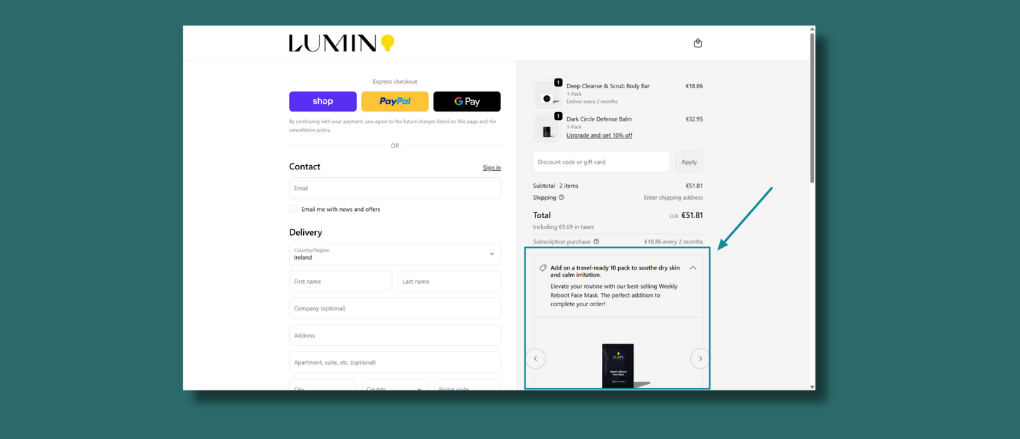8 of the Best Order Bump Examples We’ve Seen
.jpg)
Did you know that adding two order bumps can deliver $93,000 in extra annual revenue for a brand? For Shopify merchants, that is not a small lift; it is pure margin.
If you are not using order bumps, you are leaving money on the table. And if you are using them, chances are you could be doing it better.
In this post, you’ll learn what an order bump is. And you’ll see 8 of the best order bump examples we have spotted across eCommerce. Each one comes with a takeaway you can apply to your own store.
Let’s jump in!
What is an Order Bump?
At its core, an order bump is a specialized type of cross-sell. Like traditional cross-selling, its goal is to nudge shoppers toward related products that increase their average order value.
But here’s where order bumps stand apart:
- Placement: They show up right at the point of purchase, usually on the cart page or just before checkout.
- Relevance: They are tightly tailored to the product a shopper already selected.
- Simplicity: Adding them takes one click, no extra browsing or decision-making.
- Low risk: The best order bumps are small, low-ticket items that don’t require much analysis before saying “yes.”
Take BeardBrand as an example. When a customer adds a product to their cart, they see a prompt to add shipping insurance in the cart drawer. That is an order bump in action - relevant, fast, and convenient.
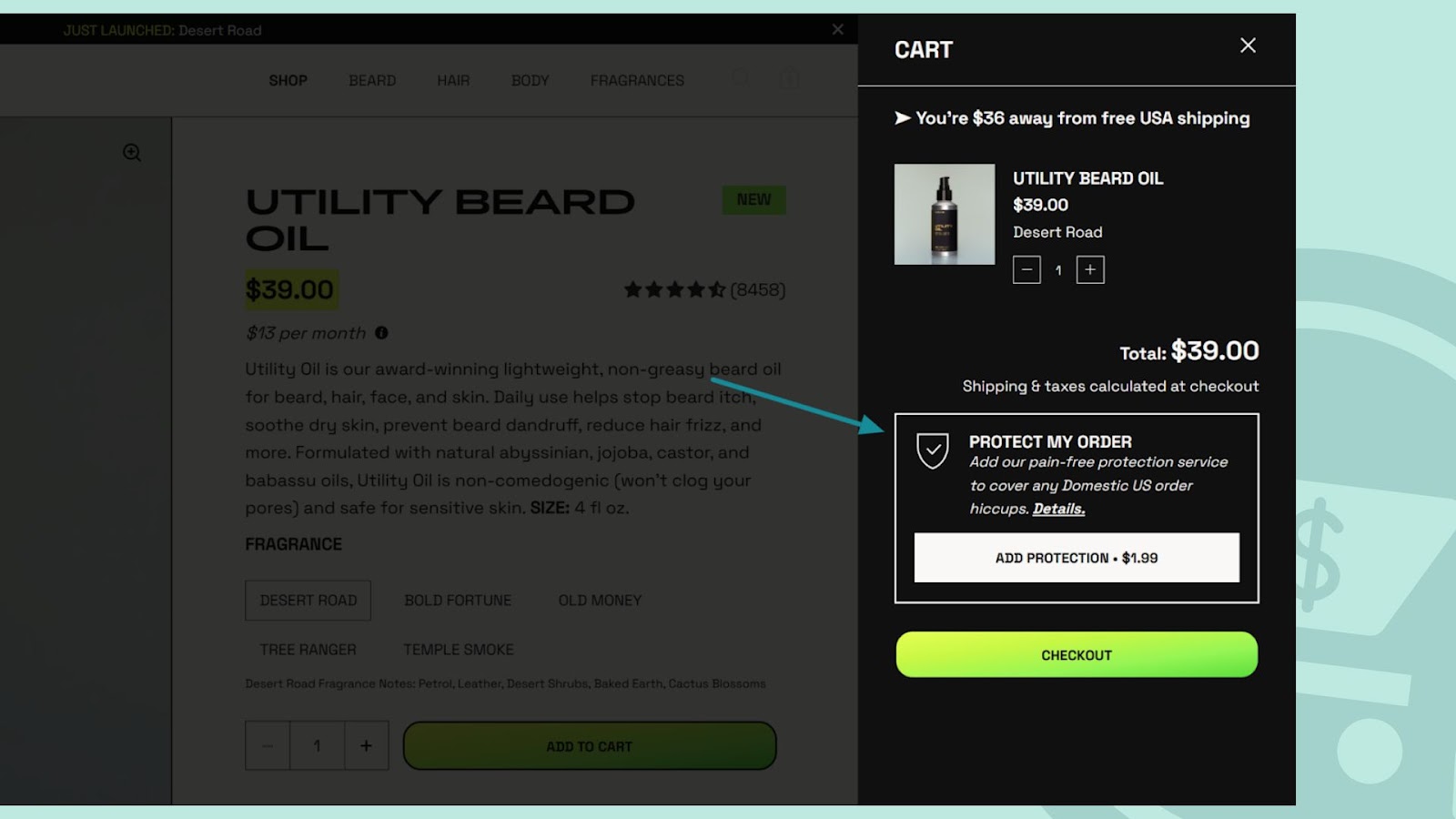
Now compare that to the “You may also like” carousel you see on many online stores. That’s a classic cross-sell, but it feels less personal, requires extra clicks, and forces shoppers to consider multiple options.
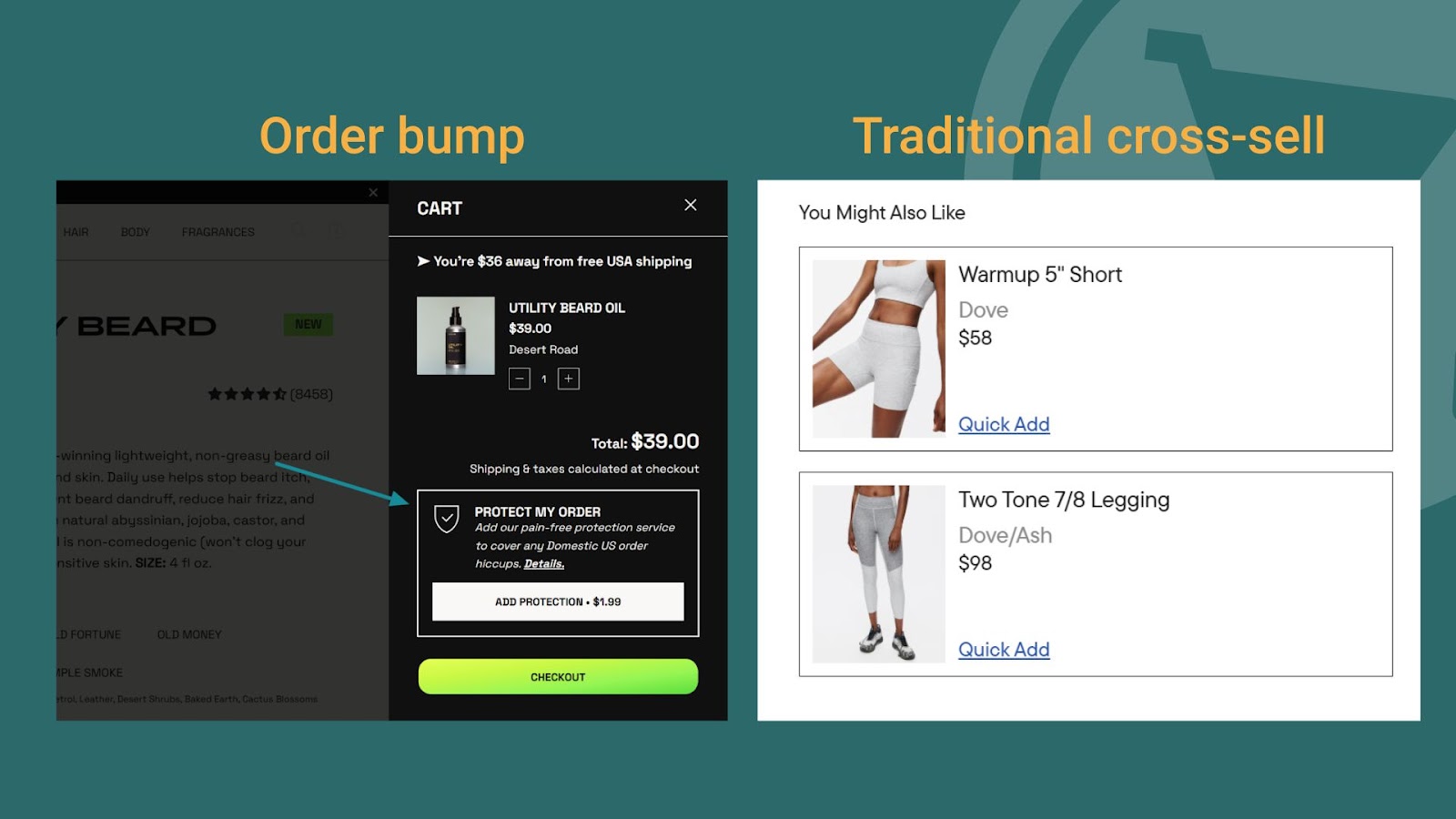
This clarity is why order bumps work so well. They catch shoppers at the exact right moment, with the exact right offer, and make it frictionless to say yes.
Order Bump vs Upsell: What’s the Difference?
It’s easy to mix up order bumps and upsells since both are designed to boost AOV. But they’re not the same thing.
Here’s the quick breakdown:
- Order bump: A small, low-risk add-on shown during checkout. Example: “Add gift wrapping for $4.99.”
- Upsell: A higher-value upgrade or bundle offered before or after checkout. Example: “Upgrade to the deluxe package for $50 more.”
The biggest difference? Timing and size. Order bumps show up during the purchase journey, require just one click, and work best for low-ticket items.
Upsells often come before or after checkout, ask for more money, and need more consideration.
Smart Shopify merchants use both tactics together. Order bumps typically capture quick wins at checkout & post-purchase, while upsells maximize revenue at every other stage of the funnel.
8 Amazing Order Bump Examples to Learn From
Now that we’ve clarified what order bumps are, let’s get into the fun part: real-world examples.
These aren’t theoretical - they’re proven tactics that brands are using today to lift AOV and drive incremental sales.
1. Ratio Coffee - Seamless Accessory Add-On
🎯The tactic: Ratio Coffee sells a $359 premium coffee machine, and inside the cart slide-out, they offer a $34.50 Able Basket Coffee Filter with a single click.
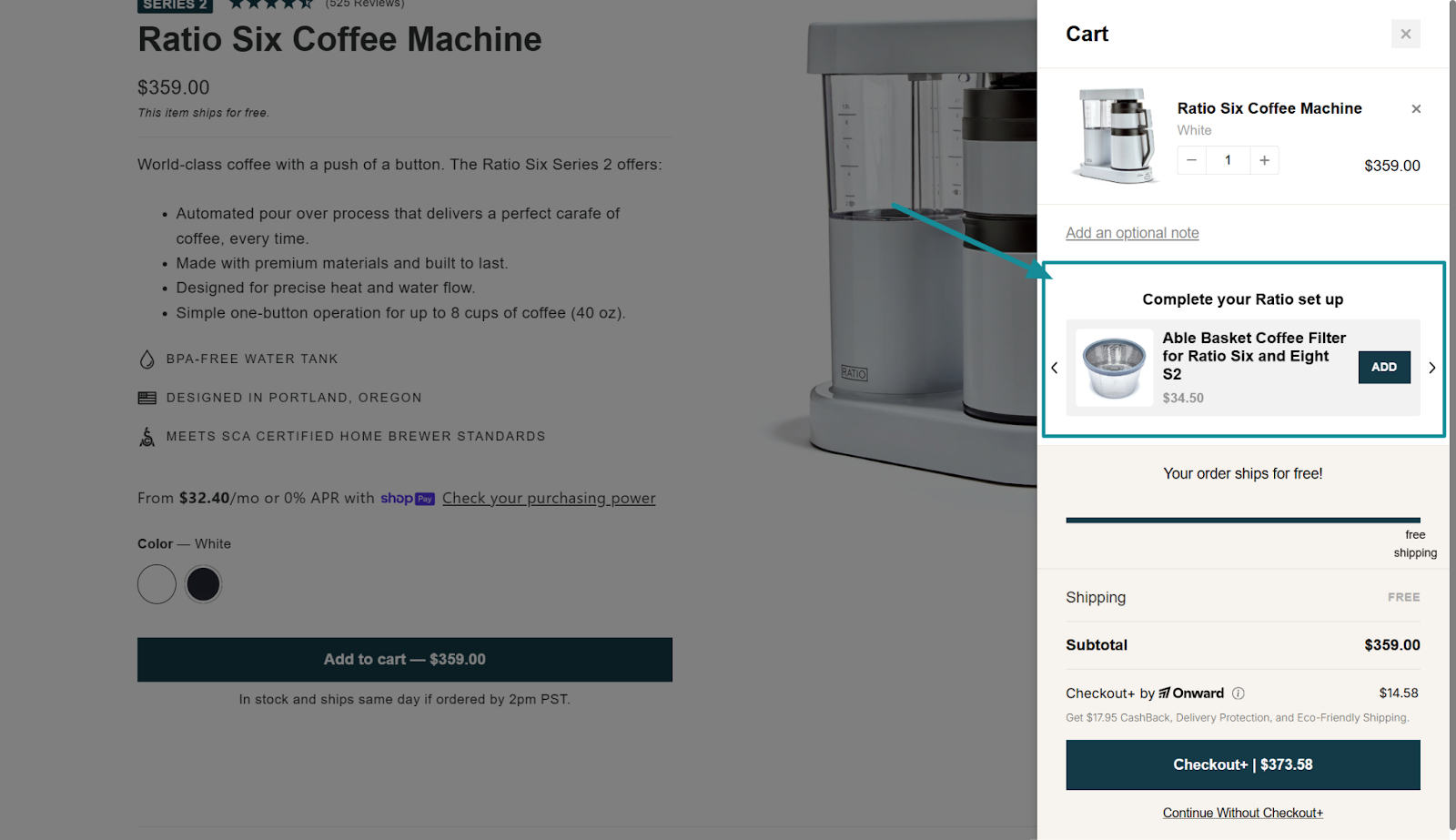
🧠The psychology: When a customer commits to a high-ticket item, their price sensitivity drops. In this case, the $34.50 filter feels almost negligible compared to the main purchase - but it’s essential for use. The bump isn’t just “extra,” it’s a completion cue that ensures the machine works at its best.
🥷How you can steal it: If you sell a hero product, identify the one accessory that makes it feel complete. Position it not as an optional add-on, but as the natural finishing touch. Think in terms of “Don’t forget this piece, you’ll need it” rather than “Want to add more?”
2. ProFlowers - Same-Day Delivery Upgrade
🎯The tactic: ProFlowers gives shoppers the option to add $4.99 for same-day delivery when selecting their date on the calendar.
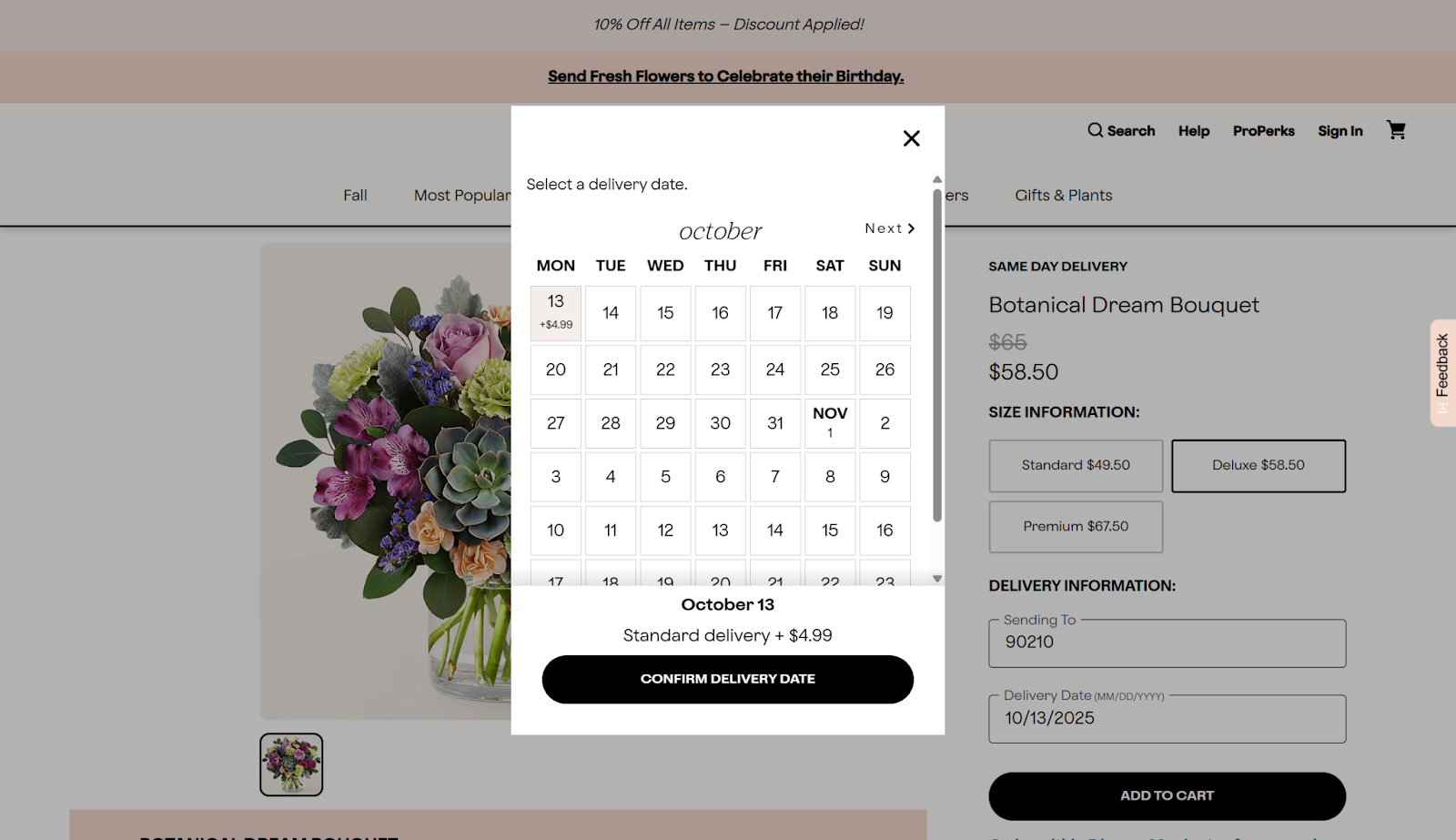
🧠The psychology: This bump taps into urgency and emotion. Flowers are often bought for occasions like birthdays, anniversaries, or apologies - moments where “today” matters more than “tomorrow.” By framing the upgrade as a small, flat fee, ProFlowers captures extra revenue while solving a time-sensitive pain point for the customer.
🥷How you can steal it: If your product is giftable or tied to special occasions, test delivery- or timing-based bumps. Think faster shipping, rush processing, or even premium unboxing experiences. Customers in a hurry are usually happy to pay a little more for peace of mind.
3. Laumière Gourmet Fruits - Thank-You Page Order Bump
🎯The tactic: Laumière Gourmet Fruits used Upsell.com (formerly ReConvert) to add post-purchase order bumps on the thank-you (order confirmation) page - turning the moment after checkout into a fresh revenue opportunity.
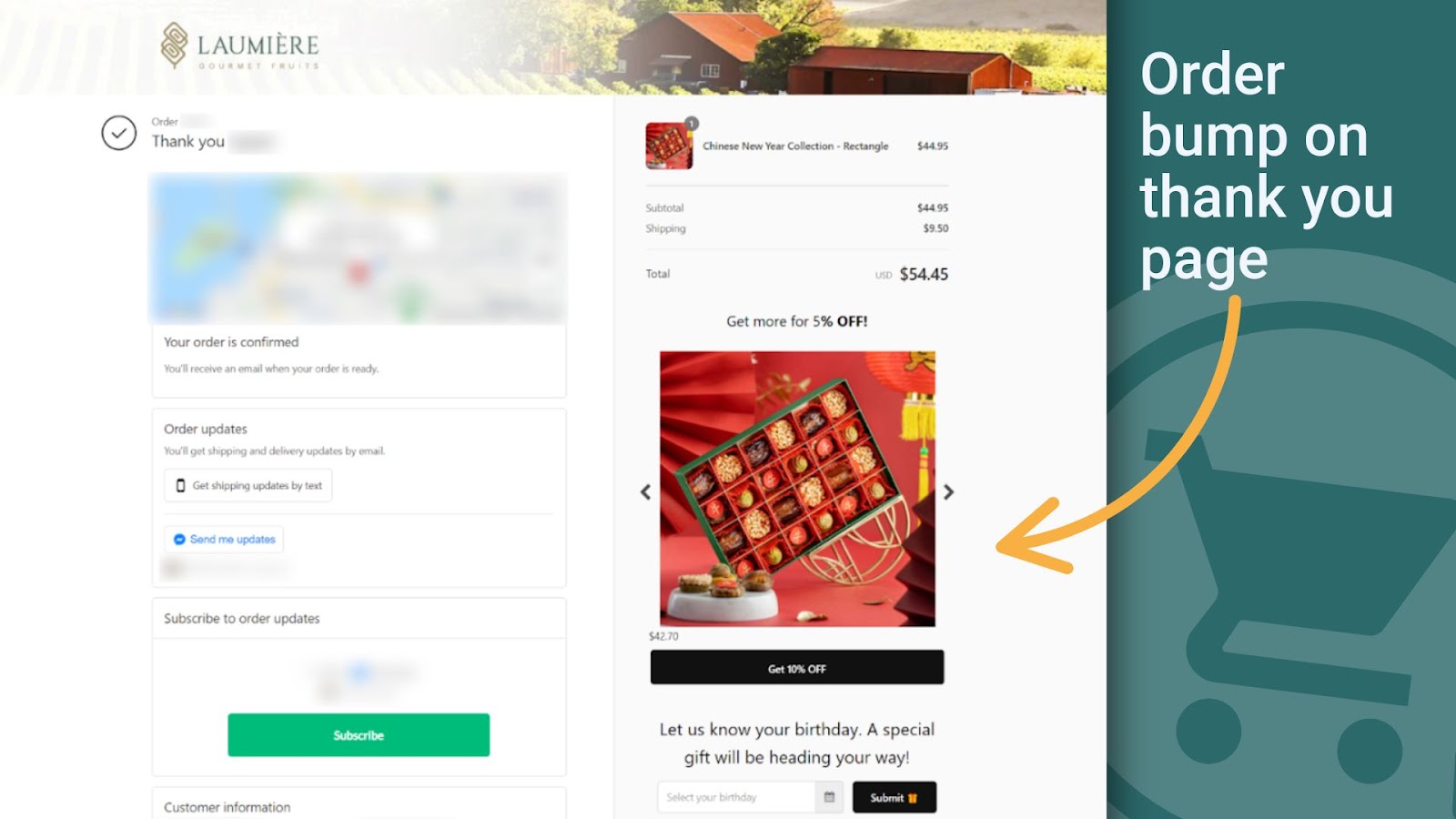
🧠The psychology: After someone completes a purchase, they’re already in a buying mindset. That “honeymoon window” is a prime moment to suggest complementary items. Because the main decision is done, buyers feel less risk - it’s psychologically easier to say “yes” to a small add-on than to initiate a whole new purchase.
💰The results (from their case study):
- They achieved a 7.01 % conversion rate on the thank-you page upsells.
- Laumière saw +10.3 % growth in revenue within three months
- They also recorded a 4,346 % return on investment (ROI) against app fees.
🥷 How you can steal it: Don’t let the buyer leave your funnel immediately after checkout -use the thank-you page to surface persuasive, complementary offers. Use urgency or scarcity (e.g. limited-time discount) to push the add-on. Test different layouts, formats (pop-up vs embedded), and offers to discover what resonates on your brand’s thank-you page.
{{cool-component="/style"}}
4. GoPro - “Free” Membership That Converts to Paid
🎯The tactic: When a customer adds a new camera to their cart, GoPro prompts them to include a 1-year GoPro Premium Subscription. The subscription is free for the first year, then auto-renews at €49.99 annually.
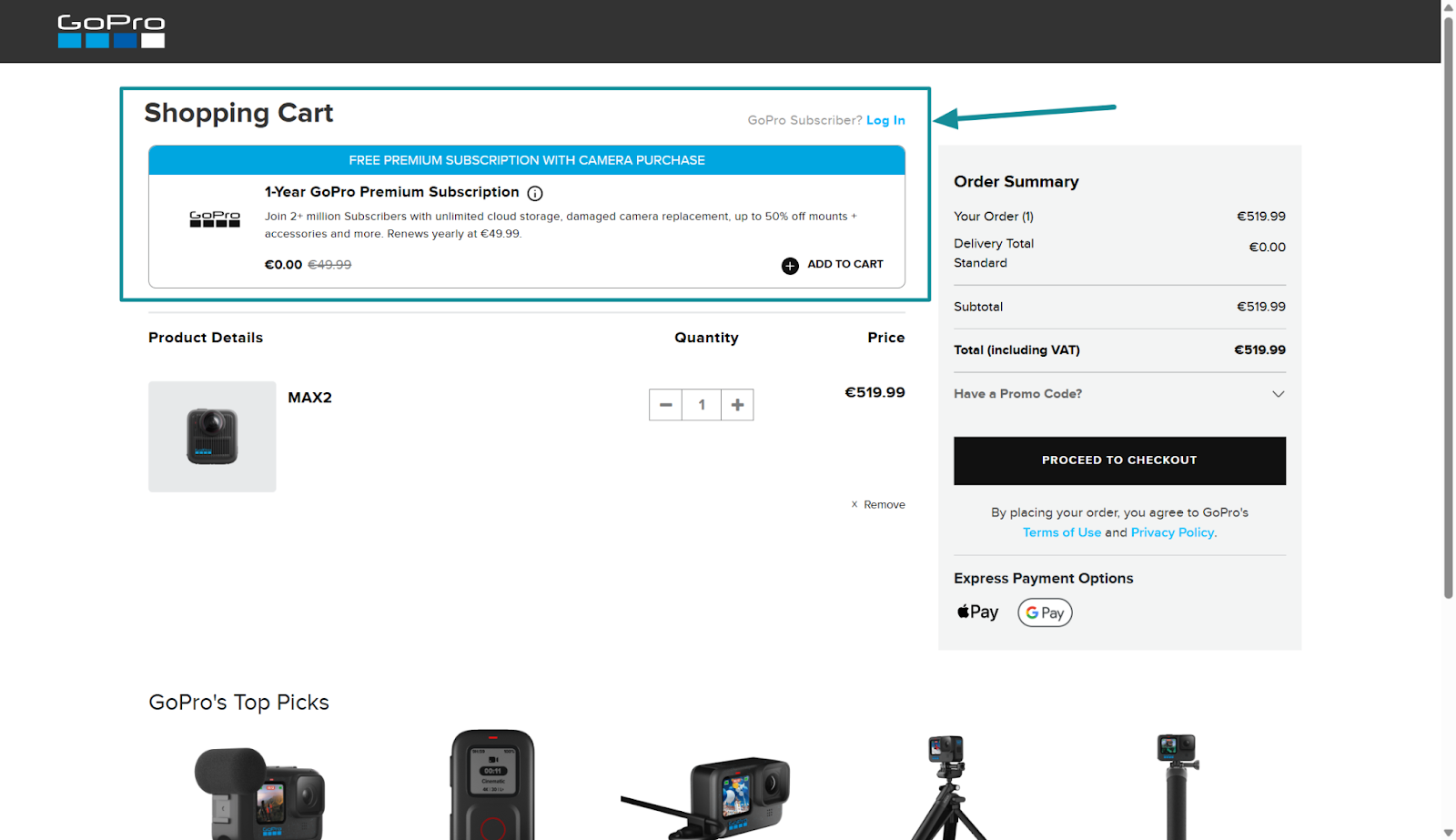
🧠The psychology: This order bump is all about anchoring and habit-building. Shoppers get a sense of extra value (“worth €49.99, yours for free”) at the moment of purchase, which increases perceived deal quality. Once they’ve used the platform for a year - unlimited cloud storage, discounts on mounts, camera replacement - the subscription feels too valuable to lose. That makes renewal at full price a natural step.
🥷 How you can steal it: If you offer any kind of digital service, loyalty program, or membership add-on, consider bundling a free trial (even a month) as an order bump. Customers are already in buying mode, so adding it feels painless. The key is ensuring the subscription delivers ongoing value, so they stick around once the paid cycle begins.
5. Native Cosmetics - “Complete Your Routine” Checkout Upsell
🎯The tactic: At checkout, Native prompts shoppers to “Complete Your Routine” by adding a body wash for $11 alongside their deodorant purchase.
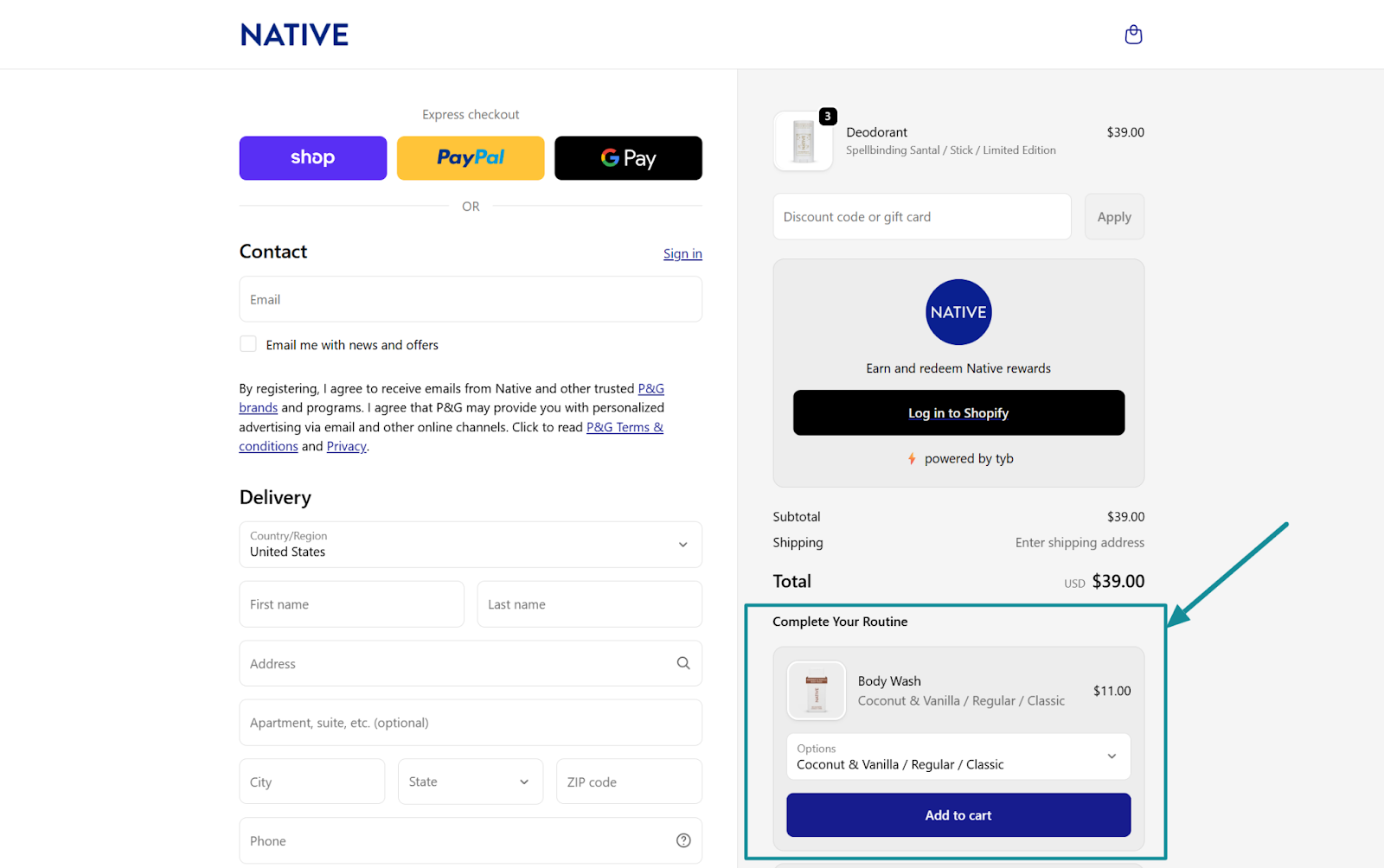
🧠The psychology: This bump works because it taps into the desire for completeness and convenience. Shoppers don’t want to feel like their order is missing a piece, and the phrase “Complete Your Routine” makes the upsell feel like a natural extension. It also saves them time - adding body wash now means fewer future shopping trips.
🥷How you can steal it: Look at how your products fit into routines, rituals, or systems. Frame your bump not as an “add-on,” but as a way to finish the set. Words like “complete your kit” or “build your bundle” create a sense of wholeness, which increases conversion.
6. Ridge - Cart Upgrade With Discounted KeyCase
🎯The tactic: When a shopper adds a Ridge Wallet to their cart, Ridge presents an “Upgrade & Save” offer for their Ridge KeyCase, discounted from €89 to €27.
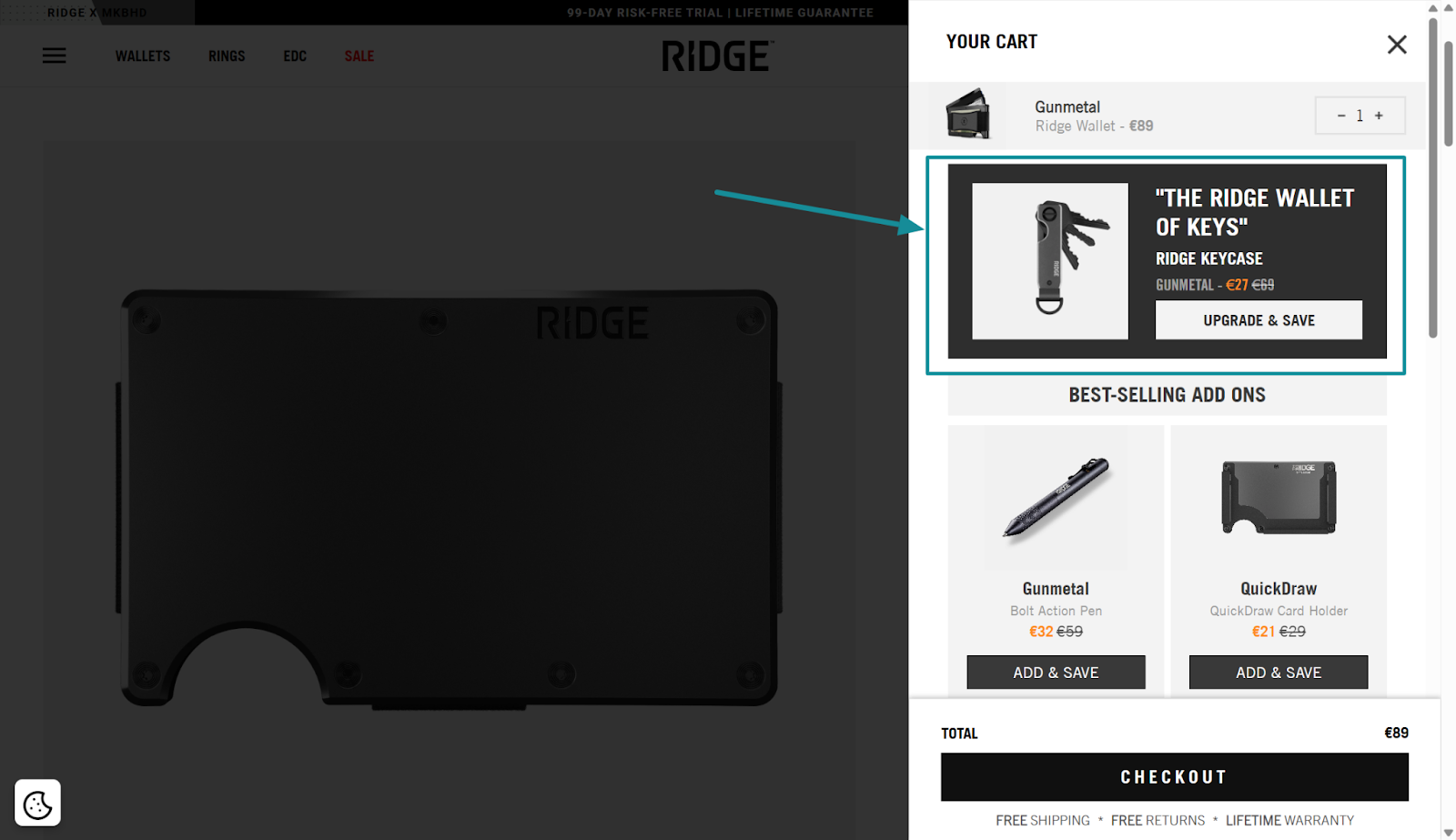
🧠The psychology: This move blends bundling and perceived savings. By showing the KeyCase as a natural companion to the wallet and slashing the price at checkout, Ridge leverages FOMO (fear of missing out on the deal). The shopper is already committed to the premium wallet purchase, so the discounted upgrade feels like grabbing extra value, not extra spending.
🥷 How you can steal it: Test bundle-style bumps where the add-on is positioned as part of a set. Sweeten it with a limited-time or in-cart discount, so the bump feels exclusive to that exact moment. Words like “upgrade & save” or “complete the bundle” make the order bump irresistible.
7. Olivia Jewelry – The $15 Mystery Ring
🎯The tactic: Olivia Jewelry offers shoppers the chance to add a “Mystery Ring” to their cart for $15 (discounted from $29). The ring is an adjustable size, so there’s no sizing barrier, and the exact style is a surprise.
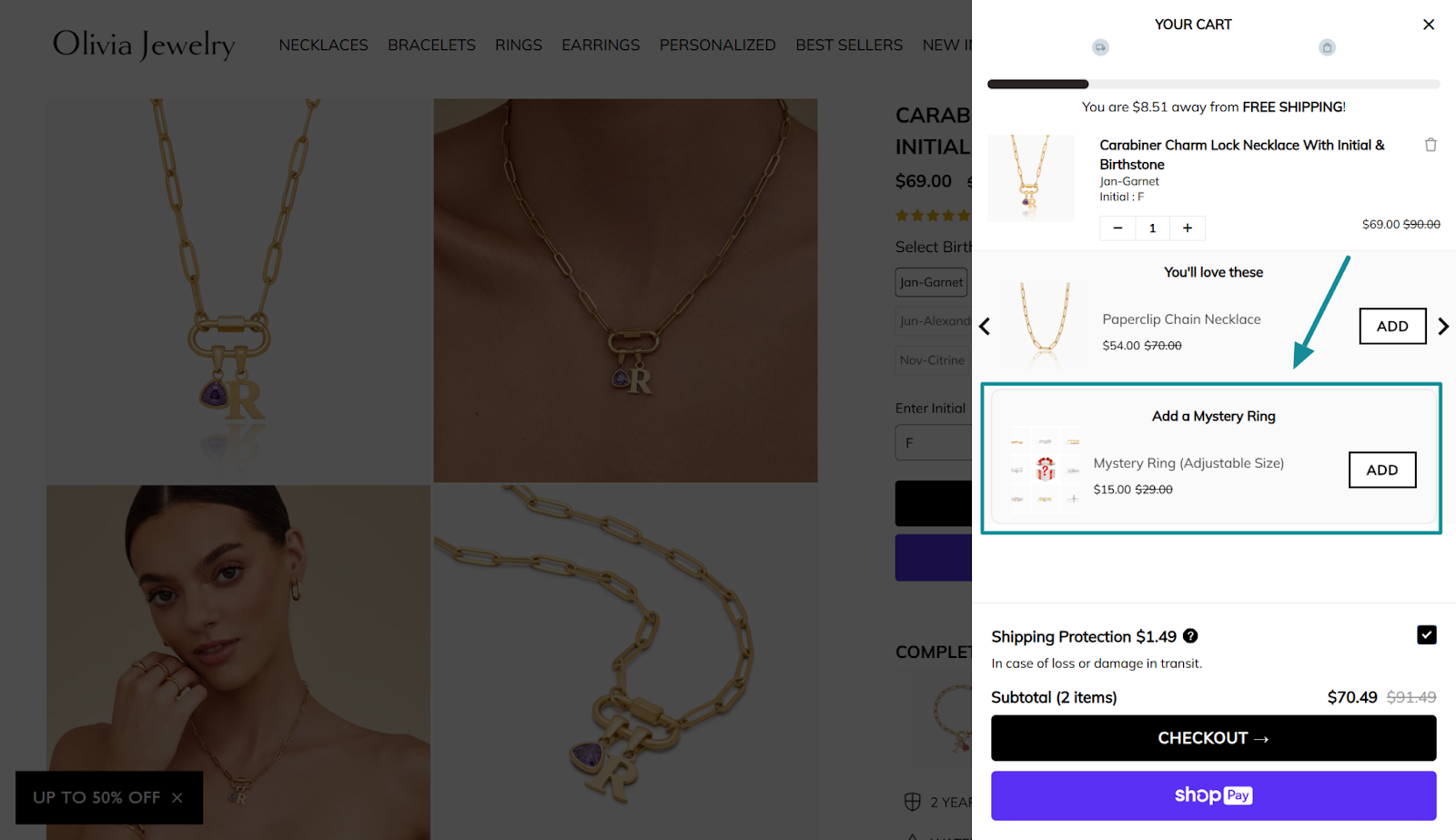
🧠The psychology: This order bump leans on curiosity and perceived value. Shoppers get the thrill of a surprise, similar to blind boxes or subscription boxes, paired with a clear discount anchor ($29 down to $15). It also doubles as a clever way for Olivia to move slower stock without discounting it in a way that hurts the brand image.
🥷How you can steal it: If you have SKUs that move slowly or leftover seasonal stock, wrap them in mystery packaging. Position it as a “surprise gift” or “mystery pick” and price it low enough to feel like a no-risk gamble. You’ll turn inventory headaches into revenue drivers.
Suggested Reading: How Olivia Jewelry Unlocked an Extra $138,678 With Post-Purchase Upsells
8. One-Click Post-Purchase Upsell Page
🎯The tactic: Instead of ending the journey at the thank-you page, many brands insert a dedicated one-click upsell page immediately after checkout. Customers see a single, time-sensitive offer that can be added to their order without re-entering payment details.
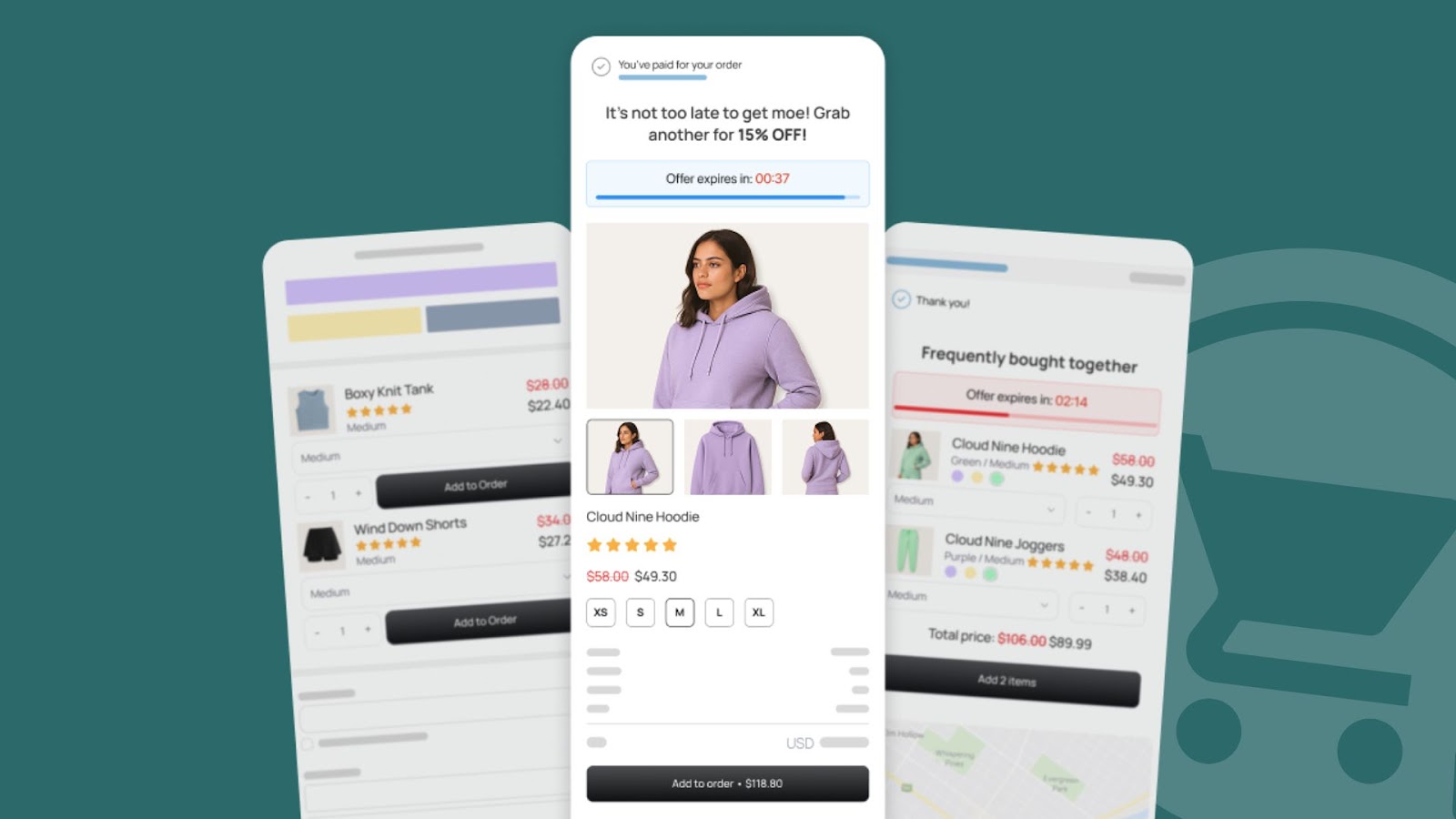
🧠The psychology: This format works because it leverages commitment momentum. Once a shopper has completed their order, they’re still in “buy mode.” By removing friction (no re-entering payment info) and keeping the offer highly relevant, merchants can capture impulse revenue at scale. It’s also a smart spot for bundles or higher-margin items that might have been too distracting earlier in the funnel.
🥷How you can steal it: If you’re on Shopify, tools like Upsell.com make it easy to add post-purchase upsells. Keep the page focused: one clear offer, strong visuals, and urgency copy like “Only available with this order.” Avoid overwhelming customers with too many options — simplicity converts best here.
Case Study: Hike Footwear’s Checkout Order Bump That Drove $677K+ in Extra Revenue
Hike Footwear, a barefoot-style shoe brand, wanted to lift their average order value without cluttering checkout or risking conversion rates. Their customers already loved the comfort and alignment of their minimalist footwear, but the brand knew there was untapped potential to increase revenue from each transaction.
The Order Bump Strategy
Using Upsell.com (formerly ReConvert), Hike Footwear layered in upsell opportunities across the customer journey. The first move was a checkout cross-sell: when shoppers added shoes to their cart, they saw an offer for orthopedic insoles at 50% off. This was no random add-on - the product complemented the core purchase perfectly.

Next, they introduced a one-click post-purchase upsell, shown immediately after checkout, which allowed customers to add another product without re-entering payment details.
Finally, they transformed the thank-you page into a conversion asset, embedding relevant upsells to give customers one more chance to increase their order.
The Results
Over just seven months, this strategy delivered:
- $138,223 from checkout cross-sells
- $267,803 from one-click post-purchase upsells
- $281,121 from thank-you page offers
In total, Hike generated $677,147 in additional revenue with an average 13.05% upsell conversion rate. In practice, more than one in eight customers accepted at least one bump or upsell.
Why It Worked
The key to their success came down to three things: relevance, timing, and layering. Insoles were a natural fit with shoes, so the upsells felt helpful rather than pushy. The one-click post-purchase flow capitalized on customers’ buying mindset without adding friction. And by stacking offers across checkout, post-purchase, and thank-you page, Hike multiplied their opportunities to convert.
For Shopify merchants, the lesson is clear: when you align upsells with customer needs and present them at the right moment, the impact compounds. For Hike, a simple order bump became a revenue engine worth over half a million dollars.
{{cool-component="/style"}}
Best Practices for Effective Order Bumps
By now, you’ve seen how brands from coffee to jewelry to footwear use order bumps to grow revenue. But how do you make sure your bumps convert? Here are the principles that separate high-performing bumps from wasted checkout clutter.
- Keep It Relevant: Your bump should feel like a natural extension of the main purchase. Gift wrap for jewelry, filters for coffee makers, insoles for shoes. Random add-ons erode trust and distract customers.
- Price Smart: The sweet spot is usually $5 - $30, depending on your AOV. Low enough to be a no-brainer, high enough to make a real impact on margins.
- Minimize Friction: Every extra step kills conversions. The best order bumps are true one-click adds that don’t require shoppers to re-enter payment info or leave the checkout flow.
- Use Psychological Triggers: Order bumps work best when they tap into real customer psychology. Implement one or more of the following psychological triggers:
- Urgency: faster shipping, rush processing, limited-time add-ons
- Completion: finish the set, complete your routine
- Savings: bundle discounts, exclusive checkout-only prices
- Curiosity: mystery items or surprise gifts
- Don’t Overload the Page: One or two carefully chosen bumps is enough. Flooding the checkout with offers can tank conversions and feel desperate.
- Test, Don’t Assume: Even small tweaks in copy or placement can change performance dramatically. Run A/B tests with different offers and monitor analytics to find your true winners.
Use Order Bumps on Your Store Today!
Order bumps are one of the highest-ROI tactics in eCommerce. They don’t require new traffic, they don’t slow down your funnel, and when executed well, they can lift your average order value by 10–30% almost overnight.
From Ratio Coffee’s accessory add-on to Hike Footwear’s $677K in incremental revenue, the playbook is clear:
- Keep your bumps relevant and low-friction
- Use psychology to make them feel natural, not pushy
- Layer opportunities across checkout, post-purchase, and thank-you pages
- Test and iterate until you find the sweet spot
If you’re serious about scaling your Shopify store, you can’t afford to ignore order bumps. They’re the fastest path to more profit without more ad spend.
👉 Ready to put these ideas into action? Start your free trial with Upsell.com and launch your first high-converting order bump today.
{{cool-component="/style"}}
Order Bump FAQ
Let's quickly cover some of the most commonly asked questions relating to Order bumps in eCommerce
What is an order bump in eCommerce?
An order bump is a small, one-click offer shown during checkout. It lets customers quickly add a complementary product, service, or upgrade to their cart without leaving the checkout flow.
How is an order bump different from an upsell?
Order bumps are usually low-priced add-ons that appear in the cart or checkout. Upsells are larger offers, like bundles or premium versions, that often appear before or after checkout. Both boost average order value but happen at different stages.
Do order bumps really increase revenue?
Yes. On average, Shopify merchants see a 10–30% lift in average order value when they use relevant order bumps. Case studies from brands like Hike Footwear show six-figure gains from layered upsell strategies.
What products work best as order bumps?
The best order bumps are small, logical add-ons: accessories, warranties, gift wrap, rush shipping, or complementary items that enhance the main purchase. They should be low-risk and easy to say yes to.
Can I add order bumps to my Shopify store without coding?
Absolutely. Tools like Upsell.com make it simple to create order bumps, set conditions, customize design, and track performance - all without touching code.





.jpg)

